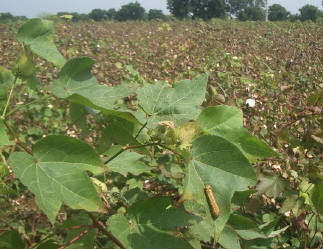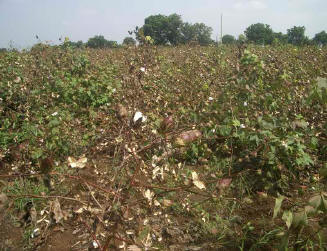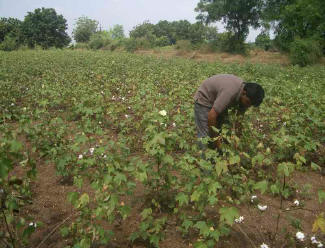Homa Farm: Tapovan
Parola, District: Jalgaon
Maharashtra, India
cotton
Comparison of Tapovan Cotton with Bt Cotton, Khandesh, Maharashtra, India
“There are four main cotton growing areas in Maharashtra, India – Khandesh, Marathwada, Vidarbha and Deccan Canal. Tapovan is situated in the Khandesh area. The GMO varieties of cotton which are known as Bt cotton have now achieved almost 100% penetration into these areas due to very aggressive marketing strategies by the seed companies.”
“Bt cotton is genetically engineered to protect the crop against only one pest – the American boll worm. However, cotton is attacked by no less than 165 pests. And now these secondary pests are attacking with great severity. The number of attacks by aphids, thrips, jassids, etc, has risen steeply since the introduction of Bt cotton in 2002.”
“Tobacco leaf streak virus, tobacco caterpillars, etc, have emerged as new diseases and pests of Bt cotton. The emergence of the mealy bug as a Bt cotton pest also appears to be a case of secondary pest resurgence, and no amount or type of pesticide has been able to control it.”
|
 |
|
|
Neighboring Bt cotton attacked by secondary pests |
Neighboring Bt Cotton attacked by Lalya disease |
“This year, the farmers of Khandesh report massive attack of the fungal wilt disease known locally as “Lalya”. Lalya seems to attack only some varieties of Bt cotton. Lalya causes an initial reddening of the leaves, then the whole plant turns red and after a few days it completely dries up and dies. In the farms surrounding Tapovan as many as 50% now show signs of Lalya wilt. Some farmers have already removed their cotton and are preparing their land for the next crop. This results in a massive economic loss to the farmers who are already in serious financial difficulty.”
|
|
|
|
Tapovan Homa cotton- up to 90 bolls per plant |
Tapovan Homa Cotton – no pest problems |
“On the other hand in the HOMA Farm “Tapovan” we have sown non Bt American hybrid, Ankur 651. The plants are smaller in height than the Bt varieties but a count of the number of cotton bolls per plant reveals an average of up to 80 or 90. This compares very favorably with the Bt varieties. Bt plants are normally much bigger in size but this does not necessarily translate into more bolls per plant. And on some farms we have counted an average of only 50 to 60 bolls per plant.”




